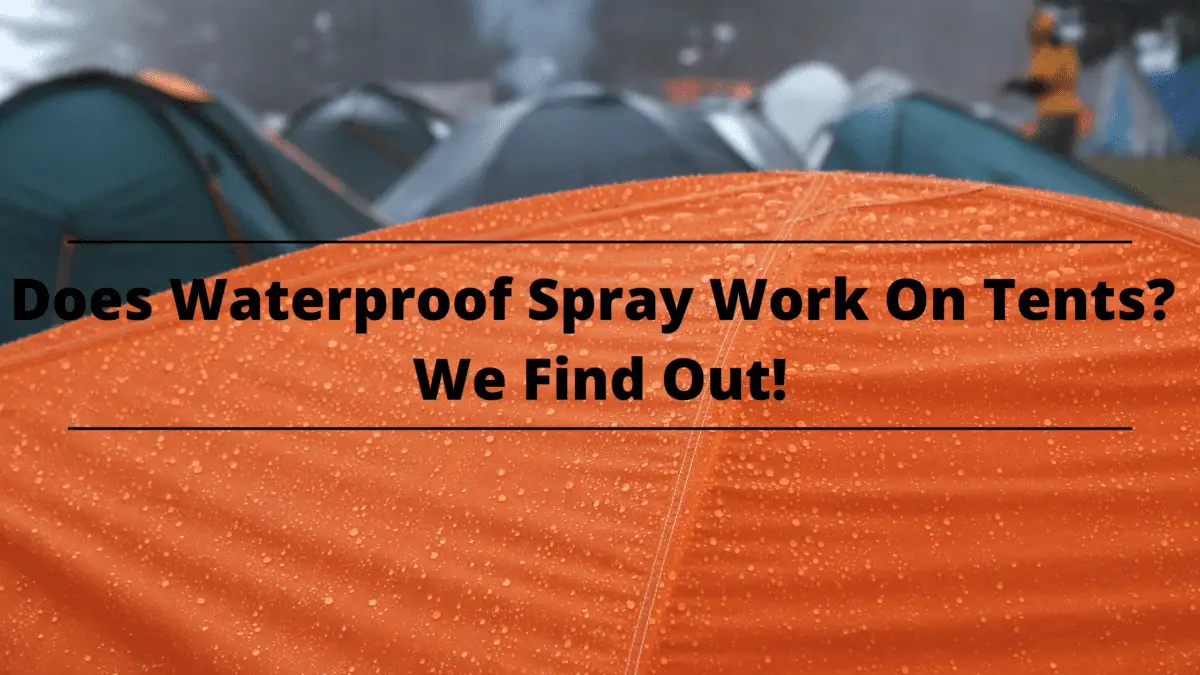Any product with a waterproof coating will eventually wear out, especially with cheaper gear. If your tent is not repelling water like it used to, maybe it’s time for some waterproof sprays. Spraying your tent with a waterproof spray will help you stay dry during your camping trip and is a great way to improve the tent’s performance and extend its lifespan.
Waterproof sprays can work on tents with proper use, provided that there are no holes on the seams. Therefore, you must check your tent and repair any holes before applying the waterproof spray.
In this article, we’ll show you how to waterproof your tent and we’ll share some knowledge about the effectiveness of waterproof sprays as well. So, read along.
The heart of your campsite is your tent. No matter how comfortable your camp may be, if you do not have a good camping tent, your camping experience will not be as satisfactory as you want it to be. If you want to invest in a good tent, check out our article on the best tents for camping where we listed and reviewed the top tents available in the market today.
Waterproofing a Tent
There are three ways to avoid water dripping inside your tent, and we’ve listed them down below, along with the steps to do it.
-
Sealing the seams
A seam sealer is best applied to help keep moisture from seeping through.
-
Refreshing the Urethane coating
This urethane coating is located on the inside of your rainfly and on the tent’s floor, which are the primary fences against moisture.
-
Refreshing the DWR
Use a durable water repellent or waterproof spray to help your tent shed water.
How to Seal the Seams
Although some tents come with sealed seams, the sealant on these can wear out over time and let water leak through. So, check your seams and repair them before your next camping trip.
What you’ll need:
- Rag
- Rubbing alcohol
- Drop cloth (to contain spills — optional)
- Seam sealer
Get the right type of seam sealer for your tent.
Some tents are constructed with silicone-treated fabrics that take a different type of seam sealer than tents made with polyurethane-coated fabrics. Check with the manufacturer if you are unsure what your tent is made of.
How to seal the seams
- The first step consists of putting your tent in a dry, brightly lit, or sunny area to help you see all of the seams. It is best to put the fly inside out to easily access the seams.
- Any loose seam tape found on the underside of the fly should be gently removed. However, leave the intact parts in place.
- Using the rag and rubbing alcohol, clean the seams.
- Apply your seam sealer to the seams.
- Note that if one seem is falling apart, the rest might follow, so it is best to apply the sealer to all the seams.
- Let the seems dry completely.
How to Refresh Urethane Coating
If there is stuff flaking off on your tent’s floor or inside your rainfly, it is time to apply a fresh layer of Urethane coating.
What you’ll need:
- Sponge (with an extra abrasive material attached to it)
- Rubbing alcohol
- Tent sealant
Again, get the right type of seam sealer for your tent. Some tents are constructed with silicone-treated fabrics that take a different type of seam sealer than tents made with polyurethane-coated fabrics. Check with the manufacturer if you are unsure what your tent is made of.
How to apply sealant
- Put your tent or rainfly flat on the floor and scrub any flaking coating. Do this gently using rubbing alcohol and a sponge.
- Apply a thin layer of tent sealant/urethane coating to the whole tent or rainfly by following the directions written on the bottle.
- Let this fresh new coat dry for 24 hours before packing it away.
- Wash your hands thoroughly after handling coated tent fabrics to reduce your exposure to flame-retardant chemicals.
How to apply waterproof spray to a tent
If your waterproof coating wears off and rain isn’t beading up anymore, you should refresh your waterproof coating.
What you’ll need:
- Waterproof spray
- Clean, damp cloth
- Water
How to apply waterproof spray:
- Set up your tent and spray it with clean water.
- If your tent is freshly washed, wait for it to dry before applying waterproof spray.
- Apply waterproof spray evenly on the tent’s exterior or rainfly.
- Next, wipe off any excess coating using a damp cloth after a couple of minutes.
- Let your tent dry completely before packing it away.
Setting up a tent in dry weather is preferable, but sometimes, you may be forced to set one up in the rain. This will make pitching your tent a little bit more challenging than usual. Follow our guide to setting up your tent in the rain to make sure that the inside of your tent stays dry.
How does waterproof spray work?
Waterproof sprays fill or penetrate the pores of the fabric, giving it a barrier of protection and allowing it to repel and keep moisture out. As the water-repellent coating wears off eventually, it’s best to apply a new coating after a few weeks. There are many waterproof sprays on the market that can make fabrics bead off water or moisture for up to four weeks.
To check if your tent has a waterproof coating, pour water onto it or on the rainfly. If you see that it runs off completely and the droplets bead off and do not leave any signs of water absorption, it is waterproofed.
Does waterproof spray work on tents?
Yes, waterproof sprays work on tents if you have completed the necessary steps to check and repair any holes on the seams and other areas before applying a coat of waterproofing spray. It will also work if you have the right waterproof spray for your tent and if it is of high quality.
In other words, waterproof sprays work 100% on tents if you do it right and use the right products.
Here are some of the best waterproof sprays for your tent:
- Nikwax Waterproofing Spray
is our top choice when it comes to the best overall waterproofing spray on the market because it provides UV protection as well. This spray from Nikwax will help prolong the life of your tent and can be used to revive your old equipment. It can also clean the dirt and grime off your tent, which means it is an all-in-one spray that will save you time and money.It works well with backpacks, tents, rainfly, tarps, umbrellas, and more. It is also a water-based, biodegradable product that contains no PFCs, VOCs, fragrance, and optical brighteners, which means it is safe and environmentally friendly. However, one of its downsides is that it might stain colored materials, so you have to spot-check before using it.
- Scotchgard Heavy Duty Water Shield
is another highly effective waterproofing spray. Most of the sprays you find on the market are more focused on nylon and polyester tents and are ineffective on canvas tents, but this Scotchgard heavy-duty water shield can waterproof nylon, polyester, polypropylene, leather, cotton, suede, and more, which means it is also effective on canvas tents.Furthermore, it is an affordable and non-toxic product that is safe to use on your boots, jackets, outdoor furniture, and a lot of other outdoor gear.
The only downside is that one canister can only provide twenty square feet of water resistance on heavier types of fabrics, so you may end up using more than two cans for a single tent.
When it comes to getting wet from the rain, you have to worry about the water from both above and below. To prevent water from soaking the bottom of your tent, you can place a tarp underneath it. To make sure that this tactic will work, you need to know how to set up a tarp under a tent.
Aerosol vs. Spray Bottles
| Spray Bottles | Aerosol Bottles | |
| Application | Pull the trigger to spray | Click to spray |
| Pros | Provide better control | Easier to use and penetrate fabrics better |
| Cons | Possibility of spraying the tent unevenly | Not environmentally-friendly, and require several cans |
Silicone vs. Non-silicone
-
Silicone-based
These are the types of sprays you’ll want to use due to their durability, safety, and waterproofing abilities. They can penetrate the fabric and will not peel off. Thus, they are very effective. However, it is not advisable to use those in some proprietary fabrics as they tend to clog pores.
-
Non-silicone-based
These types of waterproofing sprays usually contain fluorocarbons or hydros and are better for the more advanced fabric technology. However, they come with a lot of environmental downsides.
Conclusion
With proper use, waterproof sprays can work on tents, provided that there are no holes on their seams. Thus, you have to ensure that you check your tent and repair any holes or rips before applying a waterproof spray. Once you’ve repaired and sealed the tent’s seams, you can refresh its urethane coating and finish with a waterproof spray.
With proper maintenance, your tent and other camping gear can go a long way. We hope that the guide above helped you learn how to apply a waterproof spray on your tent and which waterproof spray products are perfect for your needs.


